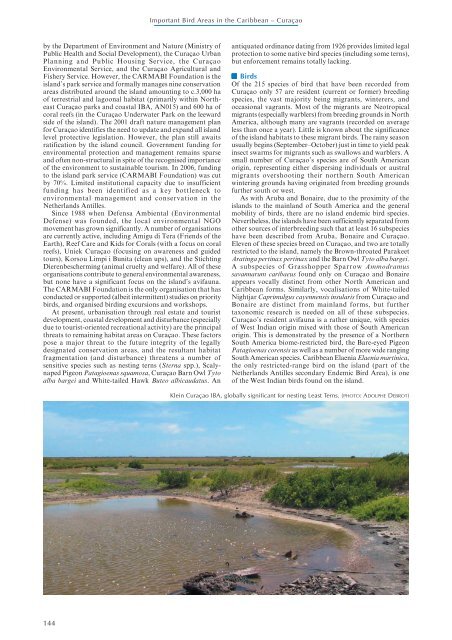Curacao - BirdLife International
Curacao - BirdLife International
Curacao - BirdLife International
You also want an ePaper? Increase the reach of your titles
YUMPU automatically turns print PDFs into web optimized ePapers that Google loves.
y the Department of Environment and Nature (Ministry of<br />
Public Health and Social Development), the Curaçao Urban<br />
Planning and Public Housing Service, the Curaçao<br />
Environmental Service, and the Curaçao Agricultural and<br />
Fishery Service. However, the CARMABI Foundation is the<br />
island’s park service and formally manages nine conservation<br />
areas distributed around the island amounting to c.3,000 ha<br />
of terrestrial and lagoonal habitat (primarily within Northeast<br />
Curaçao parks and coastal IBA, AN015) and 600 ha of<br />
coral reefs (in the Curaçao Underwater Park on the leeward<br />
side of the island). The 2001 draft nature management plan<br />
for Curaçao identifies the need to update and expand all island<br />
level protective legislation. However, the plan still awaits<br />
ratification by the island council. Government funding for<br />
environmental protection and management remains sparse<br />
and often non-structural in spite of the recognised importance<br />
of the environment to sustainable tourism. In 2006, funding<br />
to the island park service (CARMABI Foundation) was cut<br />
by 70%. Limited institutional capacity due to insufficient<br />
funding has been identified as a key bottleneck to<br />
environmental management and conservation in the<br />
Netherlands Antilles.<br />
Since 1988 when Defensa Ambiental (Environmental<br />
Defense) was founded, the local environmental NGO<br />
movement has grown significantly. A number of organisations<br />
are currently active, including Amigu di Tera (Friends of the<br />
Earth), Reef Care and Kids for Corals (with a focus on coral<br />
reefs), Uniek Curaçao (focusing on awareness and guided<br />
tours), Korsou Limpi i Bunita (clean ups), and the Stichting<br />
Dierenbescherming (animal cruelty and welfare). All of these<br />
organisations contribute to general environmental awareness,<br />
but none have a significant focus on the island’s avifauna.<br />
The CARMABI Foundation is the only organisation that has<br />
conducted or supported (albeit intermittent) studies on priority<br />
birds, and organised birding excursions and workshops.<br />
At present, urbanisation through real estate and tourist<br />
development, coastal development and disturbance (especially<br />
due to tourist-oriented recreational activity) are the principal<br />
threats to remaining habitat areas on Curaçao. These factors<br />
pose a major threat to the future integrity of the legally<br />
designated conservation areas, and the resultant habitat<br />
fragmentation (and disturbance) threatens a number of<br />
sensitive species such as nesting terns (Sterna spp.), Scalynaped<br />
Pigeon Patagioenas squamosa, Curaçao Barn Owl Tyto<br />
alba bargei and White-tailed Hawk Buteo albicaudatus. An<br />
144<br />
Important Bird Areas in the Caribbean – Curaçao<br />
antiquated ordinance dating from 1926 provides limited legal<br />
protection to some native bird species (including some terns),<br />
but enforcement remains totally lacking.<br />
■ Birds<br />
Of the 215 species of bird that have been recorded from<br />
Curaçao only 57 are resident (current or former) breeding<br />
species, the vast majority being migrants, winterers, and<br />
occasional vagrants. Most of the migrants are Neotropical<br />
migrants (especially warblers) from breeding grounds in North<br />
America, although many are vagrants (recorded on average<br />
less than once a year). Little is known about the significance<br />
of the island habitats to these migrant birds. The rainy season<br />
usually begins (September–October) just in time to yield peak<br />
insect swarms for migrants such as swallows and warblers. A<br />
small number of Curaçao’s species are of South American<br />
origin, representing either dispersing individuals or austral<br />
migrants overshooting their northern South American<br />
wintering grounds having originated from breeding grounds<br />
further south or west.<br />
As with Aruba and Bonaire, due to the proximity of the<br />
islands to the mainland of South America and the general<br />
mobility of birds, there are no island endemic bird species.<br />
Nevertheless, the islands have been sufficiently separated from<br />
other sources of interbreeding such that at least 16 subspecies<br />
have been described from Aruba, Bonaire and Curaçao.<br />
Eleven of these species breed on Curaçao, and two are totally<br />
restricted to the island, namely the Brown-throated Parakeet<br />
Aratinga pertinax pertinax and the Barn Owl Tyto alba bargei.<br />
A subspecies of Grasshopper Sparrow Ammodramus<br />
savannarum caribaeus found only on Curaçao and Bonaire<br />
appears vocally distinct from other North American and<br />
Caribbean forms. Similarly, vocalisations of White-tailed<br />
Nightjar Caprimulgus cayennensis insularis from Curaçao and<br />
Bonaire are distinct from mainland forms, but further<br />
taxonomic research is needed on all of these subspecies.<br />
Curaçao’s resident avifauna is a rather unique, with species<br />
of West Indian origin mixed with those of South American<br />
origin. This is demonstrated by the presence of a Northern<br />
South America biome-restricted bird, the Bare-eyed Pigeon<br />
Patagioenas corensis as well as a number of more wide ranging<br />
South American species. Caribbean Elaenia Elaenia martinica,<br />
the only restricted-range bird on the island (part of the<br />
Netherlands Antilles secondary Endemic Bird Area), is one<br />
of the West Indian birds found on the island.<br />
Klein Curaçao IBA, globally significant for nesting Least Terns. (PHOTO: ADOLPHE DEBROT)
















